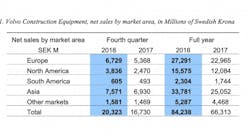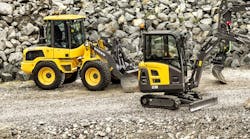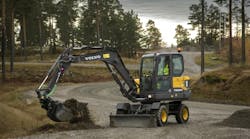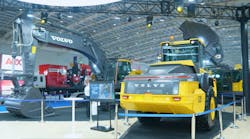Volvo Construction Equipment posted fourth quarter sales of 20.323 billion SEK (about U.S. $2.232 billion), compared to SEK 16,730 million in the fourth quarter of 2017, a 21.-5-percent increase. For the full year, Volvo CE totaled SEK 84,238 million (about $9.25 billion), compared to SEK 66.313 billion in 2017, a 27-percent leap.
Growth in both machine and service businesses, and increased demand from construction, infrastructure and mining in all major markets, helped Volvo CE deliver strong improvements in sales, operating income and order intake.
Operating income in the fourth quarter rose by 19 percent and totaled SEK 2.157 billion, with an operating margin of 10.6 percent. Earnins were positively impacted by higher sales, partially offset by higher production costs and selling expenses.
Adjusted operating income for the year was SEK 11.306 billion, compared to SEK 7.917 billion in 2017, a 42.8-percent leap, with an operating margin of 13.4 percent.
In North America, fourth quarter net sales totaled SEK 3.836 billion, compared to SEK 2.470 billion in the fourth quarter of 2017, a 55.3-percent jump, helped by a greater demand for excavators, compact and larger especially. For the full year, North America sales reached SEK 15.575 billion, compared to 12.084 billion in 2017, a 28.9-percent hike.
Demand in Europe improved during the fourth quarter, and was up 12 percent by the end of November, helped by strong growth in Russia, and moderate growth in the U.K., France, Italy and Germany. Total net sales reached SEK 6.729 billion compared to SEK 5.368 billion in Q417, a 25.4-percent increase. For the full year, European sales totaled SEK 27.291 billion compared to SEK 22.965 billion in 2017, an 18.8-percent hike.
In South America, fourth quarter net sales were SEK 605 million, compared to SEK 493 million in the year-ago quarter, a 22.7-percent leap. For the full year, SEK 2.304 billion compared to SEK 1.744 billion a year ago, a 32.1-percent jump.
Excluding China, Asia markets were up 11 percent compared to 2017, boosted by improved growth in India. The Chinese market was up strongly, growing 35 percent year over year, driven by greater demand for excavators and wheel loaders.
During the fourth quarter, Volvo CE enjoyed a 9-ercent net order intake increase, largely driven by strong demand for SDLG-branded machines in China. Order intake in Europe increased by 2 percent year over year, and in North America, order intake declined by 24 percent, because of lower orders on medium and large machines after strong demand in the third quarter, and a particularly strong period in the corresponding quarter of 2017. In Asia, order intake was up 26 percent, while in South America it dropped 5 percent and plunged 22 percent in Africa and Oceania.
“2018 was a record year for Volvo CE, driven by good demand from all major regions in the construction, infrastructure and mining sectors,” said Melker Jernberg, president of Volvo Construction Equipment. “In the future, we see further potential to increase volume flexibility in the supply chain, to improve quality and to grow our service business. An even stronger service business means that we can provide better support for our customers and also better balance the cyclicality in construction equipment sales.”
During the past year, Volvo CE continued its drive to develop next-generation solutions, progressing its position in electrification automation and connectivity. The company demonstrated electric machine prototypes during 2018 and, in a 10-week trial, the company, together with customer Skanska, tested the Electric Site concept. It is based on autonomous, electric and connected Volvo machines running in a quarry. Results shows that Electric Site can deliver significant reductions in carbon emissions as well as operator costs.
In early 2019, Volvo CE announced that it will stop developing diesel-powered smaller compact equipment in favor of fully electric machines.









